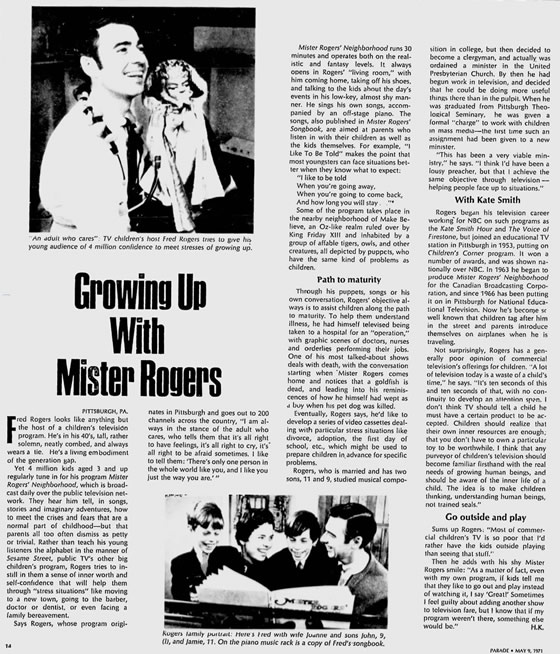Growing Up with Mister Rogers
Publication: Parade
Author: Herbert Kupferberg
Date: May 9, 1971
Fred Rogers looks like anything but the host of a children’s television program. He’s in his 40’s, tall, rather solemn, neatly combed, and always wears a tie. He’s a living embodiment of the generation gap.
Yet 4 million kids aged 3 and up regularly tune in for his program Mister Rogers’ Neighborhood, which is broadcast daily over the public television network. They hear him tell, in songs, stories and imaginary adventures, how to meet the crises and fears that are a normal part of childhood – but that parents all too often dismiss as petty or trivial. Rather than teach his young listeners the alphabet in the manner of Sesame Street, public TV’s other big children’s program, Rogers tries to instill in them a sense of inner worth and self-confidence that will help them through “stress situations” like moving to a new town, going to the barber, doctor or dentist, or even facing a family bereavement.
Says Rogers, whose program originates in Pittsburgh and goes out to 200 channels across the country, “I am always in the stance of the adult who cares, who tells them that it’s all right to have feelings, it’s all right to cry, it’s all right to be afraid sometimes. I like to tell them: ‘There’s only one person in the whole world like you, and I like you just the way you are.’”
Mister Rogers’ Neighborhood runs 30 minutes and operates both on the realistic and fantasy levels. It always opens in Rogers’ “living room,” with his coming home, taking off his shoes, and talking to the kids about the day’s events in his low-key, almost shy manner. He sings his own songs, accompanied by an off-stage piano. The songs, all published in Mister Rogers’ Songbook, are aimed at parents who listen in with their children as well as the kids themselves. For example, “I Like To Be Told” makes the point that most youngsters can face situations better when they know what to expect:
“I like to be told
When you’re going away,
When you’re going to come back,
And how long you will stay…”
Some of the program takes place in the nearby neighborhood of Make Believe, an Oz-like realm ruled over by King Friday XIII and inhabited by a group of affable tigers, owls, and other creatures, all depicted by puppets, who have the same kind of problems as children.
Path to maturity
Through his puppets, songs or his own conversation, Rogers’ objective always is to assist children along the path to maturity. To help them understand illness, he had himself televised being taken to a hospital for an “operation,” with graphic scenes of doctors, nurses and orderlies performing their jobs. One of his most talked-about shows deals with death, with the conversation starting when Mister Rogers comes home and notices that a goldfish is dead, and leading into his reminiscences of how he himself had wept as a boy when his pet dog was killed.
Eventually, Rogers says, he’d like to develop a series of video cassettes dealing with particular stress situations like divorce, adoption, the first day of school, etc., which might be used to prepare children in advance for specific problems.
Rogers, who is married and has two sons, 11 and 9, studied musical composition in college, but then decided to become a clergyman, and actually was ordained a minister in the United Presbyterian Church. By then he had begun work in television, and decided that he could be doing more useful things there than in the pulpit. When he was graduated from Pittsburgh Theological Seminary, he was given a formal “charge” to work with children in mass media – the first time such an assignment had been given to a new minister.
“This has been a very viable ministry,” he says. “I think I’d have been a lousy preacher, but that I achieve the same objective through television – helping people face up to situations.”
With Kate Smith
Rogers began his television career working for NBC on such programs as the Kate Smith Hour and The Voice of Firestone, but joined an educational TV station in Pittsburgh in 1953, putting on Children’s Corner program. It won a number of awards, and was shown nationally over NBC. In 1963 he began to produce Mister Rogers’ Neighborhood for the Canadian Broadcasting Corporation, and since 1966 has been putting it on in Pittsburgh for National Educational Television. Now he’s become so well known that children tag after him in the street and parents introduce themselves on airplanes when his is traveling.
Not surprisingly, Rogers has a generally poor opinion of commercial television’s offerings for children. “A lot of television today is a waste of a child’s time,” he says. “It’s ten seconds of this and ten seconds of that, with no continuity to develop an attention span. I don’t think TV should tell a child he must have a certain product to be accepted. Children should realize that their own inner resources are enough; that you don’t have to own a particular toy to be worthwhile. I think that any purveyor of children’s television should become familiar firsthand with the real needs of growing human beings, and should be aware of the inner life of a child. The idea is to make children thinking, understanding human beings, not trained seals.”
Go outside and play
Sums up Rogers: “Most of commercial children’s TV is so poor that I’d rather have the kids outside playing than seeing that stuff.”
Then he adds with his shy Mister Rogers smile: “As a matter of fact, even with my own program, if kids tell me that they like to go out and play instead of watching it, I say ‘Great!’ Sometimes I feel guilty about adding another show to television fare, but I know that if my program weren’t there, something else would be.”

